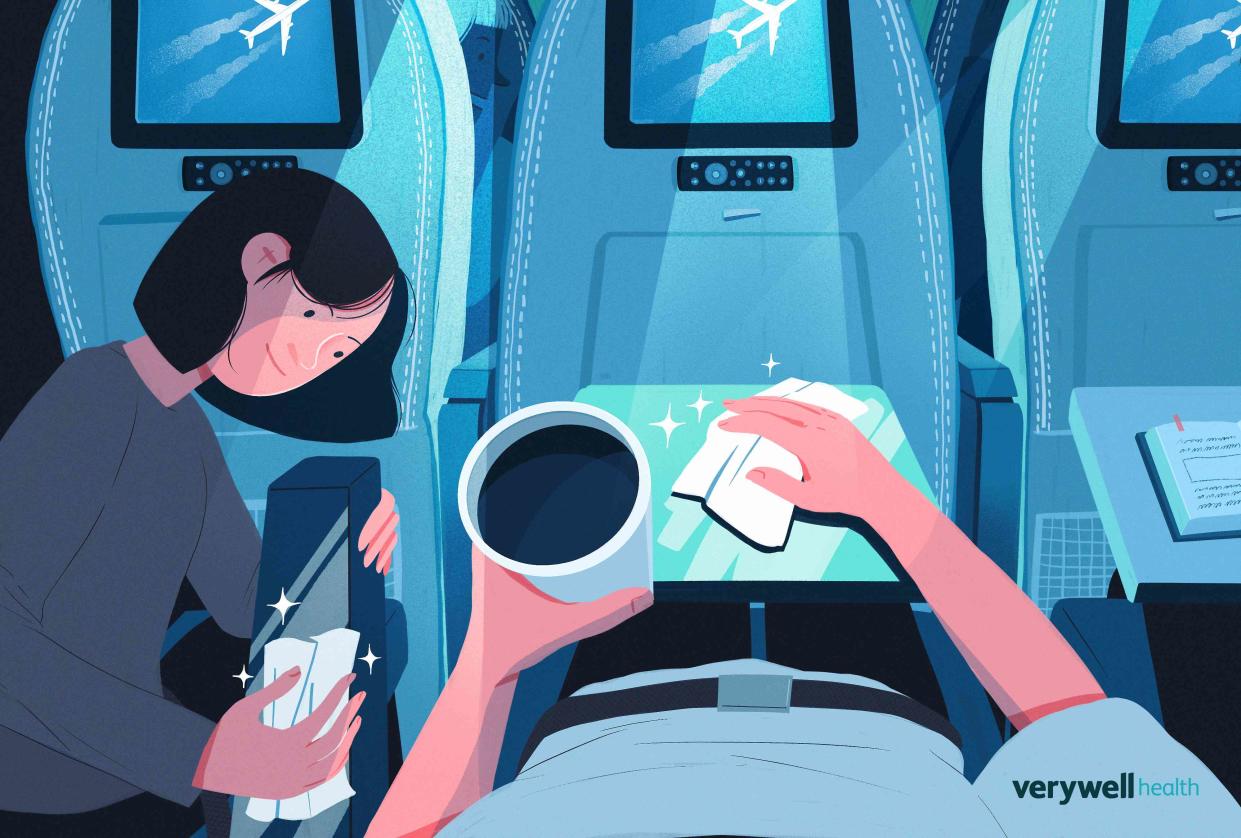Airplanes May Not Be as Dirty as You Think

Illustration by Julie Bang for Verywell Health
Fact checked by Nick Blackmer
Key Takeaways
Backseat pockets and high-touch areas like tray tables and toilet seats are likely the germiest spots on airplanes.
Most commercial airplanes have HEPA filters that remove bacteria, viruses, and fungi from the air. They also have sanitation protocols that require cleaning surfaces.
Experts say maintaining hand hygiene is more important than disinfecting surfaces.
Headlines about dirty plane seats and a “diarrhea incident” that turned into a biohazard on a Delta flight might make you think twice about flying this holiday season.
Although you can’t do much about accidents that are out of your control, there are ways to avoid unwanted germs or viruses during your flight.
Infectious diseases are spread from close contact with a sick person or surfaces that are contaminated, according to Stacey Rubin Rose, MD, an associate professor of internal medicine and infectious diseases at Baylor College of Medicine in Houston.
High-touch surfaces, including toilet seats, doorknobs, and tray tables, are probably the germiest surfaces on airplanes, Rose said, although this hasn’t been extensively studied.
“Theoretically, if you touch a contaminated surface, and then touch your own mouth or nose, you could ingest and become infected with germs from these surfaces,” Rose told Verywell in an email.
According to Brenda Orelus, a flight attendant who goes by @flightbae.b on TikTok, seatback pockets are the dirtiest surface on a plane because they’re never cleaned unless someone vomited.
Still, the odds of getting sick during a flight are relatively low.
Certain germs can live on surfaces for hours or days, and you might have seen people wiping down tray tables with a disinfectant wipe as a precaution, but it may not be necessary.
“My sense is it’s overkill. The airlines take pretty good care of planes when you land, and they sanitize everything,” said Victor DiRita, PhD, chair of the department of microbiology & molecular genetics at Michigan State University.
DiRita said to focus on hand hygiene instead of cleaning the surfaces yourself. If you’re stuck in the middle seat and can’t use the bathroom, hand sanitizer is also a good option.
“I wash my hands a lot when I’m in airports and when I’m traveling,” DiRita said.
What About Face Masks?
Air travelers aren’t required to wear masks on U.S. flights anymore, but you can protect yourself and others from respiratory infections by wearing a high-quality mask in crowded, high-trafficked areas, including airports.
“Airports are big mixing bowls, people are coming from all over the world. So, I don’t think that’s a horrible approach to travel if that’s how you feel most safe,” DiRita said.
Most commercial planes have HEPA (High-Efficiency Particulate Air) filters to remove a majority of germs from the cabin. These filters are more than 99.9% effective at removing bacteria, viruses, and fungi from the air, according to the International Air Transport Association.
However, most planes don’t turn on high-performance ventilation before takeoff. Respiratory diseases, like the flu and COVID-19, can spread in enclosed areas with poor ventilation.
“To avoid germs that are spread through ‘droplets’ or through the air, wearing a mask can be helpful. This is especially important if you have an underlying immune deficiency,” Rose said.
Related: Is It Really Time to Take Off Your Mask on Public Transit?
Flying Is Low Risk Compared to Other Parts of Your Travel
Most experts say the risk of getting sick on an airplane is not that high.
“I do not think people need to be overly concerned, though individuals with underlying medical problems or immune deficiencies may want to discuss their travel plans with a healthcare professional,” Rose said.
It might be better to think about reducing your health risk when you get to your destination. Foodborne illness is more rampant during the holiday season.
Turkey and roast beef, for instance, are linked to the bacteria Clostridium perfringens, and foodborne outbreaks related to these foods typically peak during November and December, according to the CDC.
“We’re handling turkeys and turkeys carry pathogens. So I’d be more concerned about that risk than almost any other risk that we’ve talked about,” DiRita said.
Read Next: 11 Ways to Avoid Travel Constipation
What This Means For You
Experts say that flying does not pose a serious risk for infections, especially if you are vaccinated and practice good hand hygiene. Consider talking to a trusted healthcare provider if you are concerned about your own risks.
Read the original article on Verywell Health.

